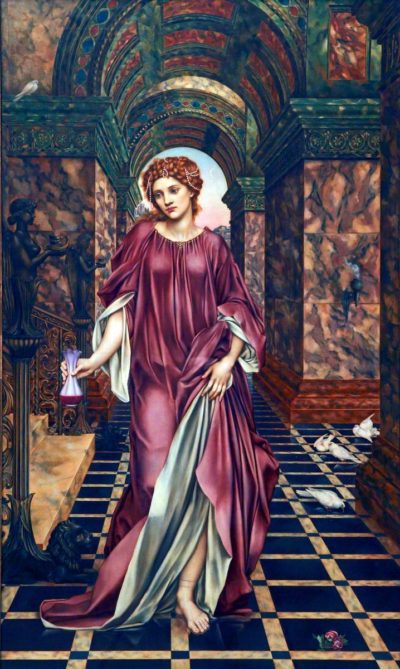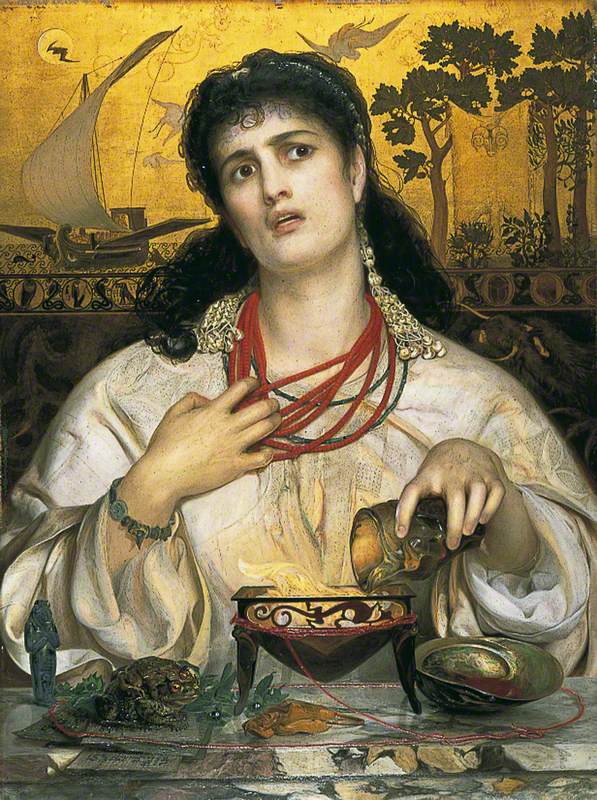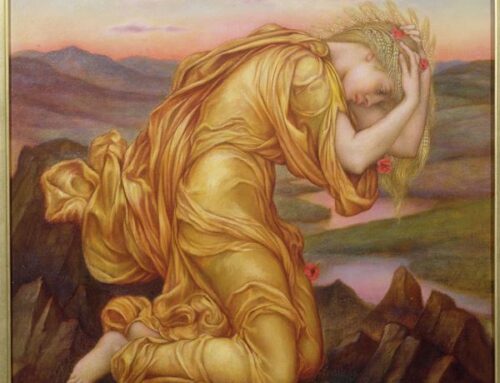
de Morgan, Evelyn; Medea; Williamson Art Gallery & Museum; http://www.artuk.org/artworks/medea-68384
One of Evelyn De Morgan’s works is – quite simply – more compelling and evocative than her 1889 masterpiece, “Medea.” This oil painting, which is now housed at the Williamson Art Gallery in Birkenhead, unveils a deeply nuanced perspective on the mythological figure of Medea. While it might be tempting to label Medea as a cold-blooded murderess, De Morgan’s rendition challenges us to reconsider her character and actions in the wider context of the suffering which had been inflicted on her. Here, we will examine the influence behind De Morgan’s portrayal of Medea and explore whether the artist extended sympathy to this tragic mother.
The Influence: Medea through the Lens of Art
Evelyn De Morgan’s idea for “Medea” probably came from the epic poem, “The Life and Death of Jason,” penned by William Morris in 1867. This work reinterprets the classical narrative, painting Medea as a tormented soul rather than the archetypal heartless sorceress. This influence sets the stage for De Morgan’s unique perspective on Medea. The artist exhibited her work alongside a stanza from Morris’ poem at the New Gallery in 1890, highlighting the significance of this new perspective in a world steeped in traditional interpretations.
“Day by day,
she saw the happy time fade fast away,
And as she fell from out that happiness,
Again she grew to be the sorceress,
Worker of fearful things, as once she was.”
Poem and painting are filled with symbols which hint that poet and painter blame Medea’s turmoil and mental torment on the deceitful Jason of Argonauts fame in classical mythology. He won Medea’s assistance in obtaining the Golden Fleece and married her, but later betrayed her, leading to her committing acts of vengeance, including the murder of her rival and her own children.
William Morris had suffered the heartache of his wife having an affair with his friend, the artist Dante Gabriel Rossetti. Maybe it was this lived experience which allowed him to empathise with Medea and see her as a figure driven to desperate measures.
Sympathy for a Murderess Mother?
One of the most intriguing aspects of De Morgan’s “Medea” is the question of whether she too extended sympathy to this character. In the classical tradition, Medea is often cast as a malevolent force, driven to unspeakable acts of violence. Yet, De Morgan’s interpretation challenges this stereotype, portraying her as a tragic figure rather than a heartless killer.
The sumptuous Rose Madder gown draping Medea, chosen deliberately by the artist, symbolizes a range of emotions, from sadness and strength to regality and purity. This choice suggests that De Morgan saw Medea not as a heartless villain but as a character driven by complex motivations. Her actions, including the murder of her romantic rival, her rival’s father, and her own children, can be reinterpreted through the lens of despair and desperation rather than her killing in cold blood.
The small details within the painting offer further insights into De Morgan’s perspective. The doves on the floor, often associated with peace and innocence, may reflect De Morgan’s view that Medea is not acting with malice. The extinguished lamps, emitting minimal smoke, symbolize the impending doom and the passage of time as Medea grapples with her dark thoughts. Even the presence of black marble in the opus sectile flooring is a subtle indicator of grief.

Sandys, Frederick; Medea; Birmingham Museums Trust; http://www.artuk.org/artworks/medea-34407
De Morgan’s depiction of Medea stands in stark contrast to Frederick Sandys 1868 version of the same subject. Sandys’ “Medea” is a tormenting and unsettling figure, actively concocting a lethal potion and exhibiting little rationality. Her depiction paints a stark contrast to De Morgan’s interpretation, where Medea is portrayed as a tormented soul wondering lonely corridors, rather than a heartless villain with lethal intent.
De Morgan’s artistic approach showcases a level of understanding for the deep psychological impact that deceitful behaviour could have on silenced women who lacked agency in ancient and her own times, reflecting her feminist ideals. Her Medea becomes a more complex and multifaceted character, highlighting the emotional turmoil and societal pressures that may have driven her to commit unspeakable acts, providing a unique lens into the depth and nuances of this classic character.






